One question I get asked a lot is “What fish can live with goldfish?” Unfortunately, it’s a lot more complicated to create a list of goldfish tank mates than it is for fish like Bettas. Some fish may be suitable for life in one goldfish community but not another. Let’s talk about how you can easily find the best companions for your goldfish tank!
Best Tank Mates For Goldfish
There’s often a trade-off when you’re picking between fish compatible with goldfish, as many species are not a perfect fit but may work in the right tank set-up.
Ideal Tank Mates For Single Tail Goldfish
Single tail goldfish are known for their bright colors and their active and curious nature. Since most single tails can reach 10 to 12 inches in length, they are best kept in a pond rather than an aquarium. Single tails usually do well over a wide range of temperatures from 60 to 80°F and readily eat a variety of fresh and commercial diets.
The best options for tankmates are other single tail goldfish, although you can also keep these goldfish with koi in a pond. Consider these ideal companions for your single-tail goldfish aquarium:
Common Goldfish
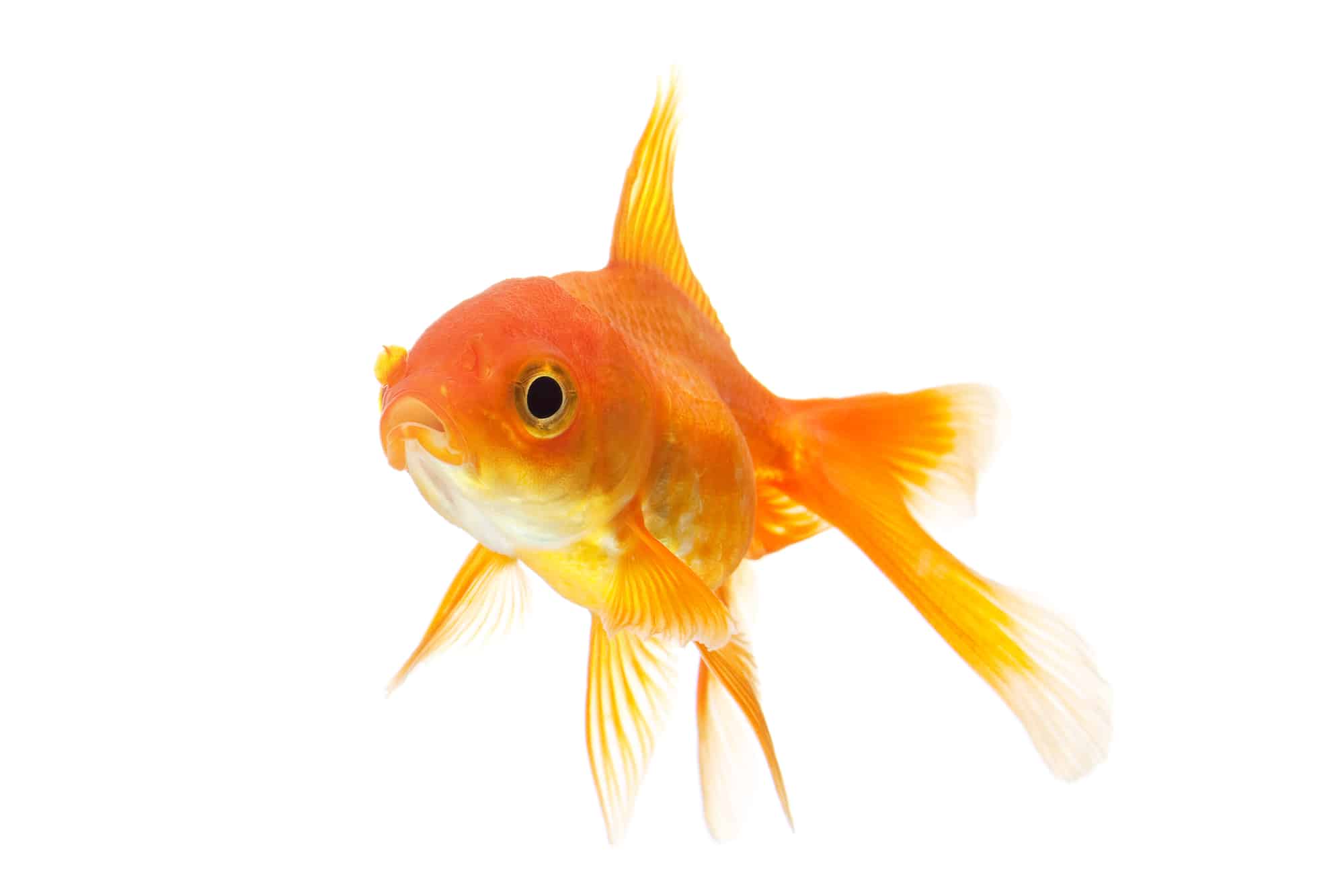
The Common or feeder goldfish is what most of us picture when we hear the name “goldfish” and are an inexpensive addition to any large tank or pond. The Common goldfish may be only a few inches long when you purchase them, but they usually grow quickly and can easily top 12-inches if they get enough food!
While a pond is ideal, you’ll need at least a 20-gallon tank for a single Common, and should add another 10 to 15 gallons on top of that for each additional feeder you add. Common goldfish are available in a wide range of colors and patterns, although many will change colors as they mature.
Comet Goldfish
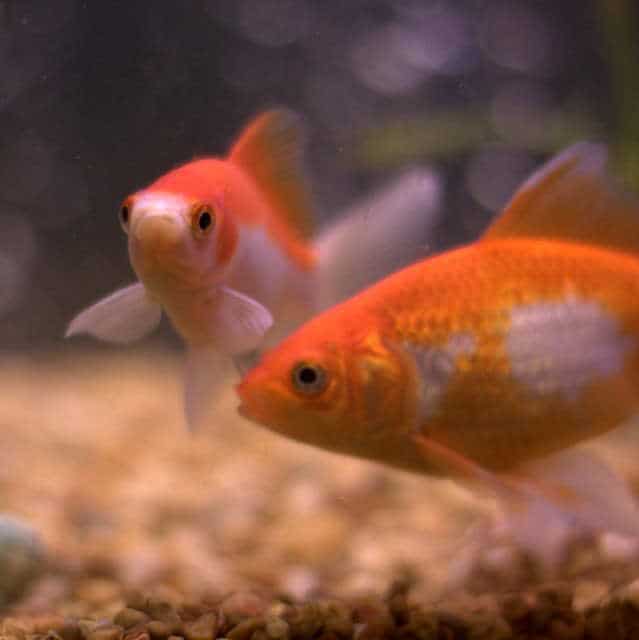
The Comet Goldfish is a bit shorter and wider than the Common and has a wide-spread tail with sharp points on them. These fast swimmers usually end up between 10 and 12-inches long at maturity and prefer soft, sandy substrates to prevent injury to their delicate tails.
Since they have a longer tail, Comet goldfish do best in bigger 50-gallon tanks and I recommend adding an additional 10 to 15 gallons for every fish you add to your community. You’ll need to be sure they don’t damage their fins on your tank decor as well. They are easy to feed and will eat flake, floating, and sinking foods.
Shubunkin Goldfish
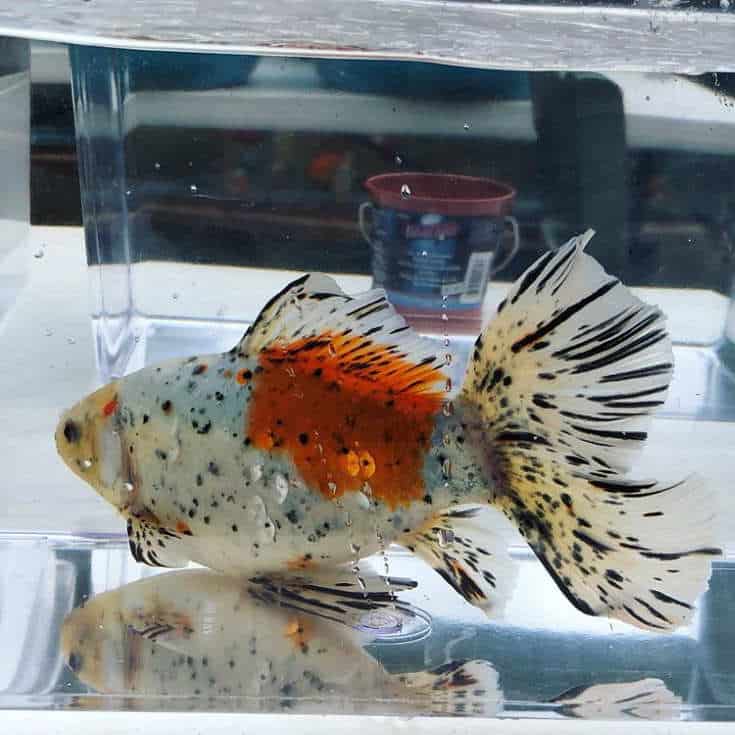
The Shubunkin is also known as the Calico goldfish, but don’t get this color morph confused with the similarly-named domestic feline! Unlike calico cats, which have at least three colors of fur, these goldfish sport a special type of scale that alters their appearance. So tri-colored goldfish are different from calicos.
Shubunkin usually looks blue with shimmering patches of red, orange, yellow, black, bronze, or pearlescent white. Any single-tailed goldfish with this trait is a Shubunkin, even if it was bred from another line. They need a minimum of a 20-gallon tank with the usual 10 to 15 gallons extra capacity per fish.
Ryukin Goldfish
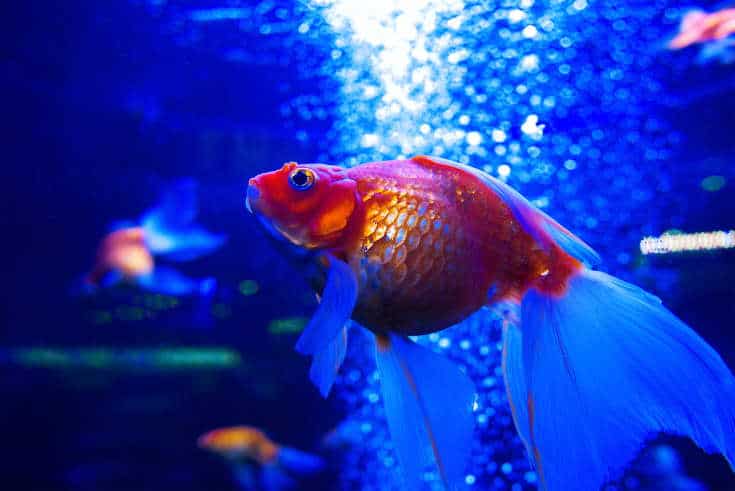
One of the more interesting options for a single-tailed goldfish companion, and a personal favorite of mine, is the fancy Ryukin goldfish. These hunched-backed fish are one of the few double tail fancy goldfish breeds that do well in ponds and as companions for single-tails!
Ryukin prefers warmer water than the others in this part of the list (from 65 to 78°F) and are usually smaller, too. They rarely hit 10-inches in length and some never grow beyond 6-inches. If your other fish are a lot larger, you could have problems with them picking on your little Ryukin, but arranging your tank differently may help.
Best Algae-Eating Companions for Goldfish
Functional tank mates, such as those that eat the algae growing on your plastic plants, decor, and substrate, often make a good addition to goldfish tanks. But what are the best algae eaters with goldfish? While smaller algae eaters may be too tiny, a few of the bigger catfish make good options for both single and double-tail tanks!
Bristlenose Plecostomus
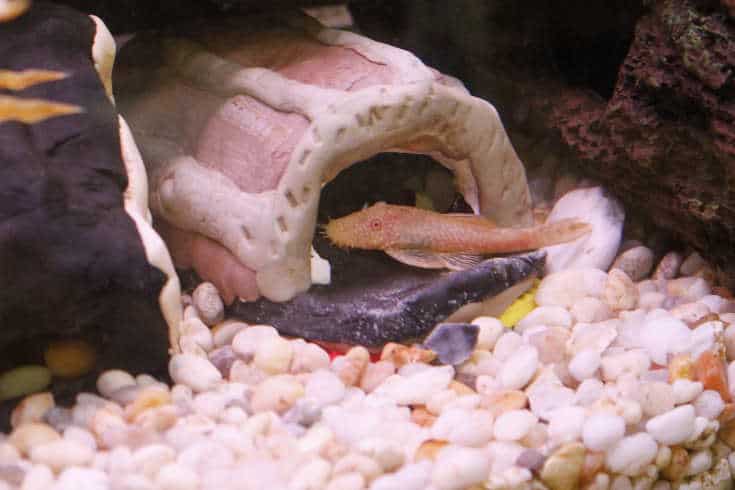
I definitely recommend the Bristlenose Pleco as an option for cleaning a tank filled with goldfish! I’ve successfully managed tanks with both hearty and fancy goldfish and never had a problem with a Bristlenose in either set-up. These comic plecos get up to 5 inches in length and sprout long tentacles around their snouts as adults.
The Bristlenose is a peaceful and mellow fish, and their armored body and spiny dorsal fins protect them for your goldfish’s nibbles. They can swim quickly, but mostly prefer to hang out on logs and the tank sides eating algae and food scraps. They can handle temps from 60 to 80°F and need about 10 gallons of extra capacity.
Rubber-Lipped Plecostomus
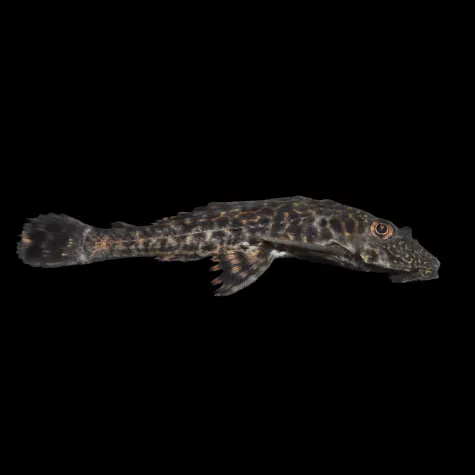
The slightly larger Rubber-Lipped Pleco is another good option for goldfish tanks, although they prefer warmer water between 72 to 80°F. These guys look like a typical pleco and are often mistaken for juveniles of other species. Reaching a maximum of 7-inches in length at maturity, they are big enough to be safe from nippy goldfish.
The biggest challenge with keeping plecos in a goldfish tank is being sure they have plenty of access to food. The goldfish will likely go after any sinking algae wafers or veggies you offer your pleco, so you may need to distract the goldfish with floating food to give the pleco time to enjoy their special meal.
Apple Snail
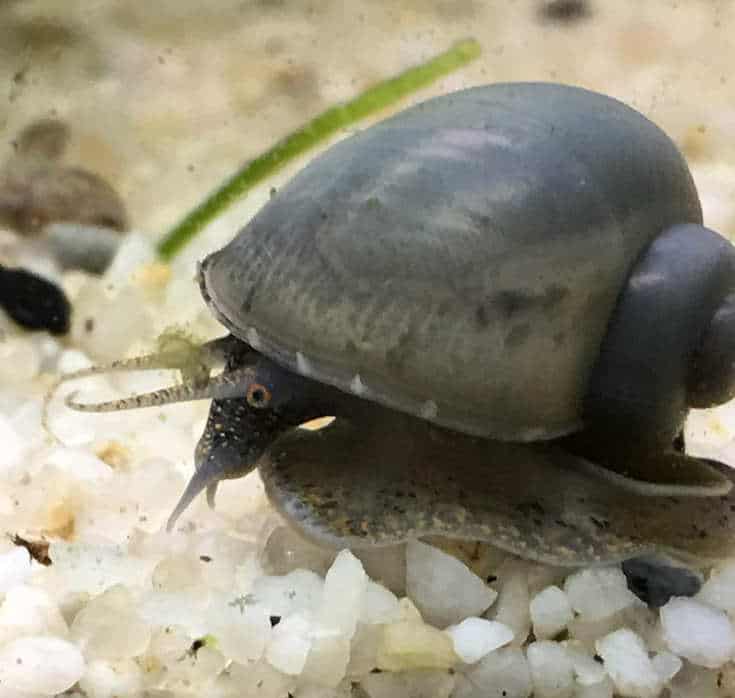
Snails and goldfish rarely work out as tank mates because goldfish enjoy eating them. While smaller Nerite and Malaysian Trumpet snails have cone-shaped shells that can harm or even kill a goldfish if they swallow them, the Apple Snail has a round shell and typically reaches between 1 to 2 inches in diameter. They are an OK algae-eater but prefer veggies and live plants.
Goldfish won’t easily be able to eat the adults, but they will definitely snack on eggs and babies. This can actually be a good thing in a goldfish tank since Apple Snails breed readily and can rapidly fill a tank with their offspring! As long as you don’t have live plants in your tank, your Apples will focus on eating algae and your fish will probably leave the bigger snails alone.
Fish Companions for Fancy Goldfish
There are hundreds of types of fancy goldfish and their specific requirements will vary depending on the type you’re keeping. Generally, though, fancy goldfish prefer warmer water stabilized with a water heater and open low-flow areas of your tank, which makes them a good fit for many other tropical fish!
Platy Fish
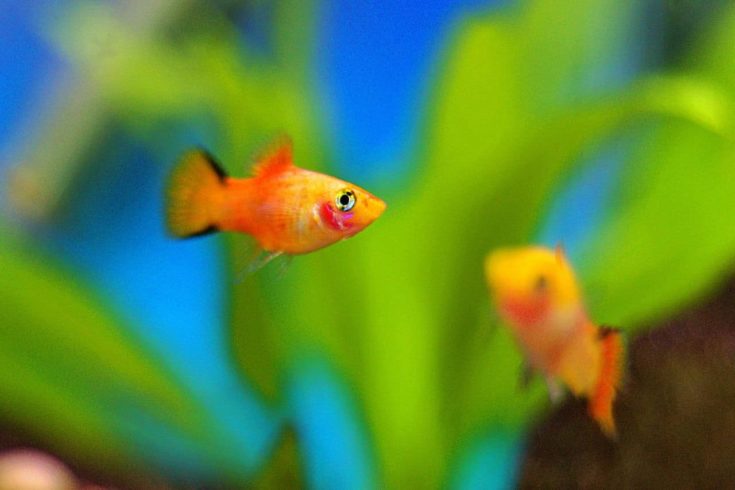
Platies are a diverse group of colorful fish in the Xiphophorus genus that typically grow to around 1.5 to 3-inches in length. They usually have a short fan-shaped tail, although the rarer male Swordtail Platy has a tail that sticks out like a spike! They come gold, red, orange, green, black, and white and have a range of patterns.
Platies can handle temperatures from 70 to 78°F and prefer to live in a group of at least 5. You can fit 5 platy fish in your goldfish tank for every 10 gallons of capacity you have free! Platys are laid back and will hang out in a group near the plastic plants in your tank, and your goldfish will probably leave them alone.
Black Skirt Tetras
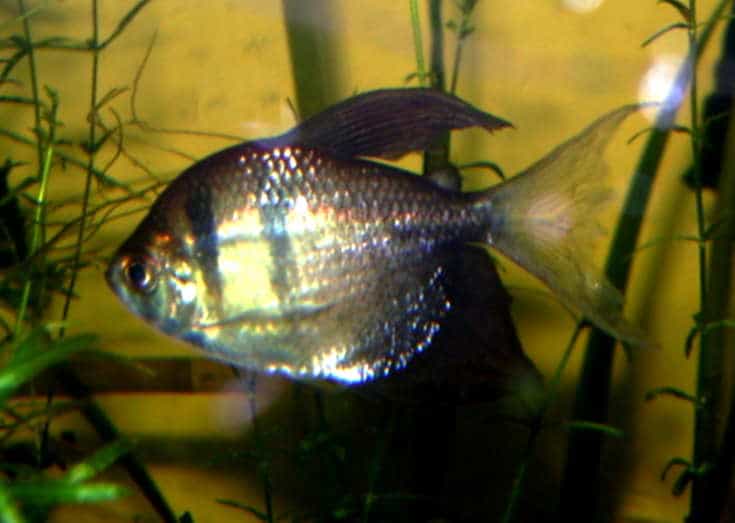
Black Skirt Tetras have a classic diamond-shaped body and are nearly as wide as they are tall. Their dorsal fin is upright, and they have a thin tail with a noticeable fork and feathery anal fin. You won’t have to worry about your goldfish nipping at them, however, because these fish are sassy and will nip right back!
Black skirt tetras reach 2 to 3.5 inches upon maturity and prefer to live in large schools of 10 or more. It’s recommended you allow an extra 15 gallons capacity for every 10 tetras you add to your tank. They usually ignore other fish when they are in large groups. Having tall plastic plants against the back of your tank will help since they like to swim in the center and can dodge into them if they feel unsafe.
Bloodfin Tetras
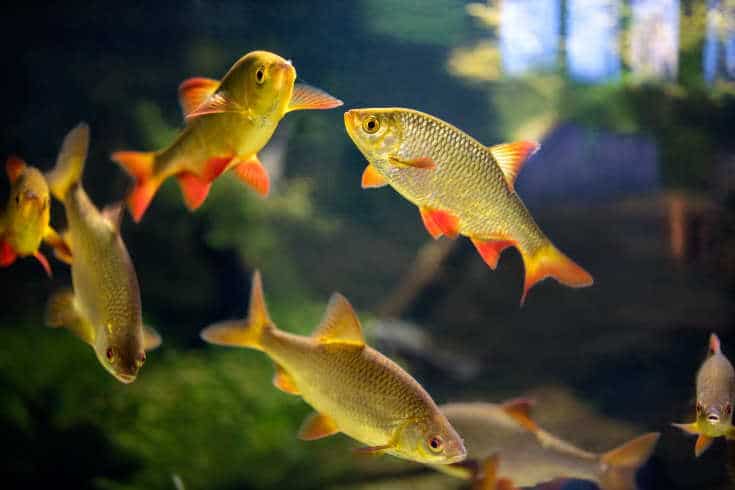
Another tetra and goldfish combo that could work is the Bloodfin Tetra. These silvery streamlined fish have red splashes of color on the bottom of their tail and anal fin and some also have a red dorsal fin! They are a peaceful and shy fish that prefers to live in schools of 5 to 7, so allow an additional 20-gallons of capacity for a small group.
They can reach between 2 to 3 inches in length as adults and enjoy swimming in open water in the center of your tank. Like the Black Skirt, Bloodfins like to have tall plants around so they can dart to safety if startled. Your goldfish may chase them at first, but these fish are fast and the school will melt into the decor, so it often works!
Checkered Barbs

Another longtime favorite of mine, the Checkered Barb is an outstanding community fish and a good option for a fancy goldfish tank. Barbs are often known for being aggressive, but Checkereds are peaceful and lively! They can reach 2-inches when fully grown, and a group of 10 needs about 20 gallons capacity in 68 to 79°F water.
Their black-and-silver checkered bodies and red fins look amazing as they school, and they enjoy a strong current to play in. They’ll spend most of their time swimming in your filter outflow if you set things upright, and your goldfish will likely leave the Checkered Barbs to themselves. These fish can be nippy in smaller groups, however.
Rosy Barbs
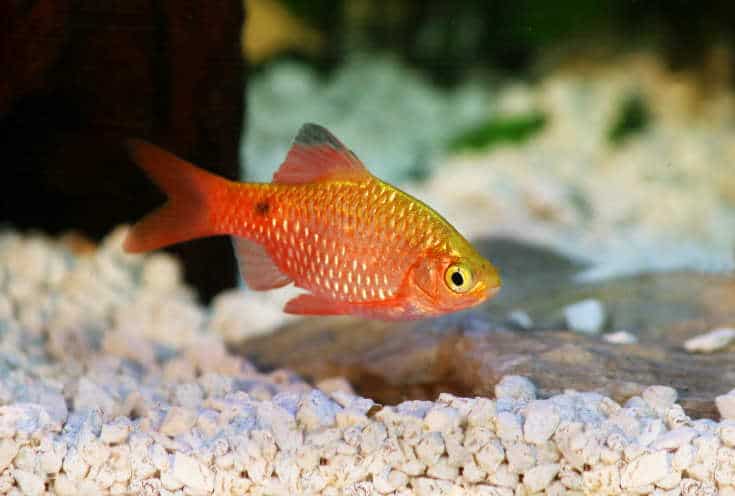
An excellent option for fancy goldfish tanks are the Rosy Barb, a blush-colored bigger cousin to the Checkered Barb. These red to pink colored fish can reach up to 6-inches in length and prefer to be in large schools of 10 or more. They prefer to swim in strong currents in the center of your aquarium.
Rosies prefer cooler water from 64 to 72°F and need a roomy tank of at least 30 gallons. I’d allow for an additional 5-gallons for every barb added to your school. While Rosies can be nippy like the other barbs, they are less likely to bother your goldfish if they are in a large school, and your goldfish will avoid the areas they enjoy.
Gold Barbs
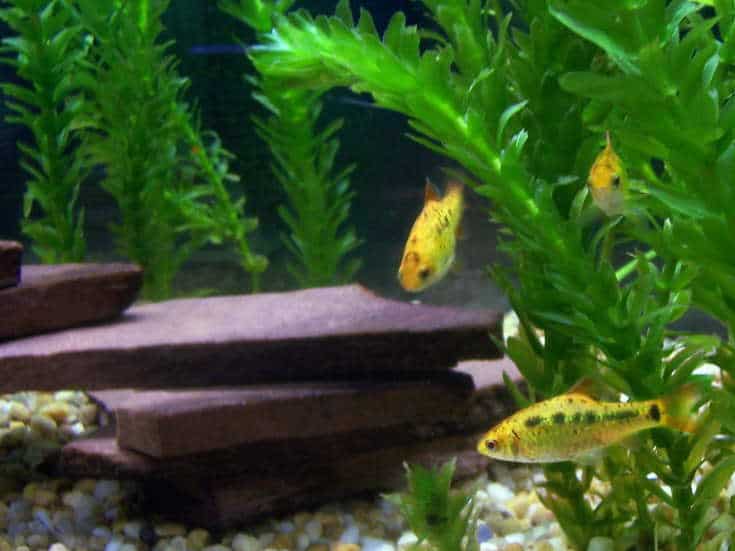
I’ve long been a fan of the mellow Gold Barb, and these peaceful gold and black fish add a lot of color to your tank! They are slimmer and more streamlined than the other barbs on the list and can reach 3-inches at maturity. They prefer water temperatures between 74 to 82°F and spend their time swimming in the lower parts of your tank.
These social fish do best in small groups of 6 or 7, and I’d allow an extra 20 gallons capacity for a group this size. While any barb can be nippy, these are some of the least aggressive and rarely causes problems in a community. They do not like to be on their own, so be sure to add them as a group instead.
Giant Danios
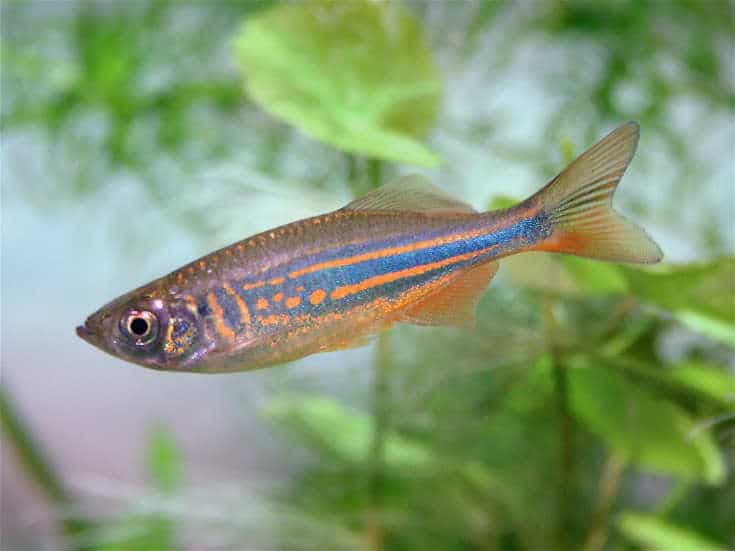
If you’re looking for a minnow you can keep with goldfish, the Giant Danio is one of the best options! Giants can reach up to 4-inches in adulthood so your goldfish won’t be able to eat them, and these schooling fish are fast swimmers too. Giant Danios are blue-green with gold markings and sparkle as a group in your tank!
Their ideal temperature range is really narrow and may be a challenge in some tanks since they prefer their water from 72 to 75°F. They also do best in groups of 5 or more and need about 5 gallons capacity per fish. Like barbs, Giants enjoy swimming in a current and will flock to those areas of your tank, leaving the still regions for goldfish.
Zebra Danios
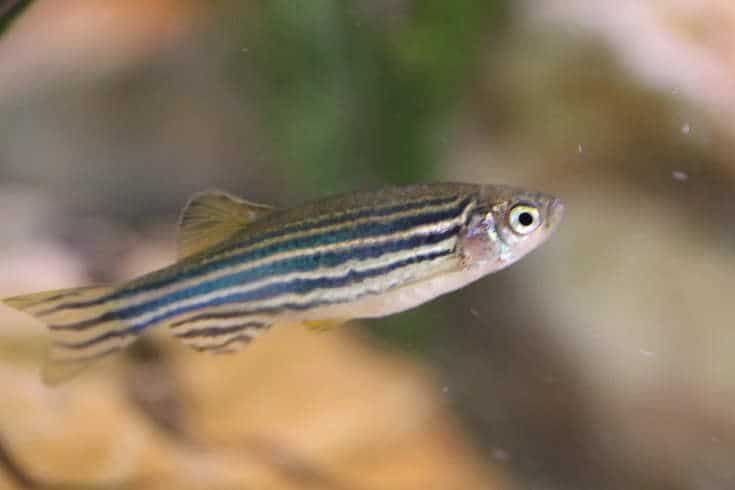
The silver and black-striped Zebra Danio is a common community fish and is easy to find in most aquatic shops or online. These small schooling fish thrive in a wide range of conditions and do well in temperatures from 65 to 77°F. They can reach up to 3-inches in length and prefer to live in groups of 6 or more in a 10-gallon tank.
Zebra Danios usually stick together, and their fast swim style makes it hard for fancy goldfish to catch them. They also prefer a mild current and will gravitate towards bubble walls and filter outflows, both areas your goldfish won’t care for. They add a nice splash of color and movement to goldfish tanks, and their budget cost makes the risk rather minimal.
White Cloud Minnows
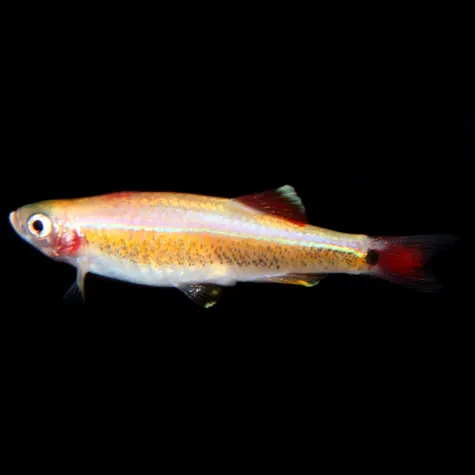
The tiny 1.5-inch long White Cloud Minnow isn’t an obvious pick for a goldfish tank, since their small size puts them at risk of being eaten. A large group of 10 to 20 in a spacious goldfish tank, however, often works out well because the slower goldfish can’t keep up with the school! You’ll need at least a group of 10 for this to work.
White Clouds are a very pretty and colorful fish with silver-green scales and a pink to red tint to their fins. They do well in tanks from 64 to 72°F and prefer a heavily planted tank with a rocky substrate. If you offer them some floating plants and decorations to hide under they’ll probably be content. Allow at least 10-gallons for every group of 10 you add to your goldfish community.
Japanese Rice Fish
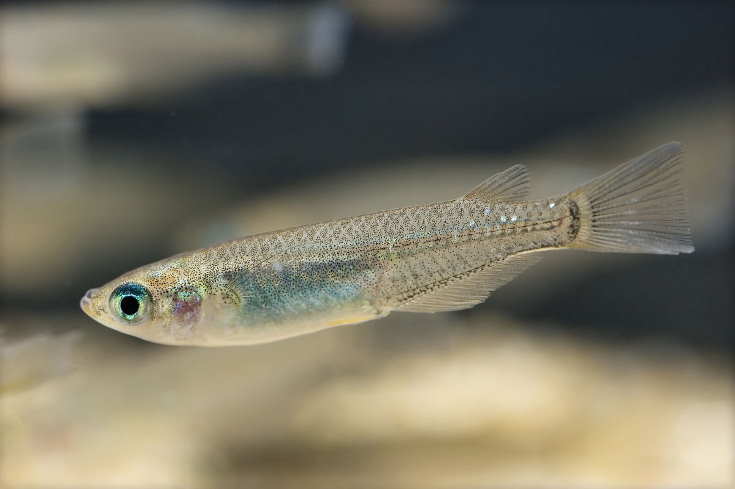
The Japanese Rice Fish, also known as the Medaka, is an interesting species that can survive in fresh, brackish and marine tanks! These 1.6-inch long white fish with yellow highlights prefer densely planted tanks and enjoy schooling in the center and top. They do well in temperatures from 64 to 72°F and are an ideal community fish.
The Medaka is not a common fish and you may have to search for them online. I’ve never seen them in any of my local aquarium stores. It’s best to keep them in large groups of 10 or more to deter your goldfish from nipping at them. I’d allow an extra 15 gallons of capacity per group of 10, and offer them some tall plants against the back of the tank for hiding.
River Murray Rainbow Fish
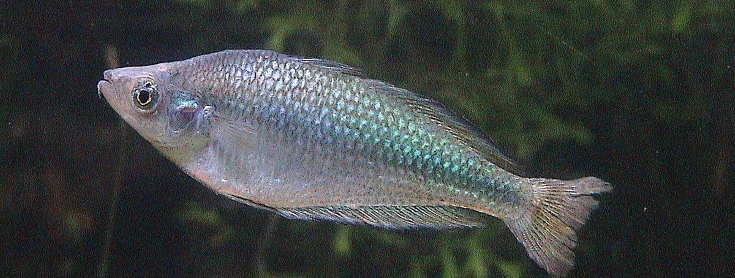
These colorful silver, blue and green fish are native to the River Murray in Australia and can reach up to 4-inches in length. They tolerate a wide range of temperatures in the wild and seem to show the best colors when kept in cooler water from 70 to 78°F. They are a newer aquarium species and we’re still learning about their ideal care.
They seem to do best in groups of at least 4 and can be nippy with slow-swimming fish like Bettas. You’d probably do best by allowing 20-gallons of free capacity for a group of 4 to 6. Interestingly, they have also been kept in large 75-gallon tanks with single tail goldfish and often do well in smaller tropical fancy goldfish tanks!
Scissortail Rasbora
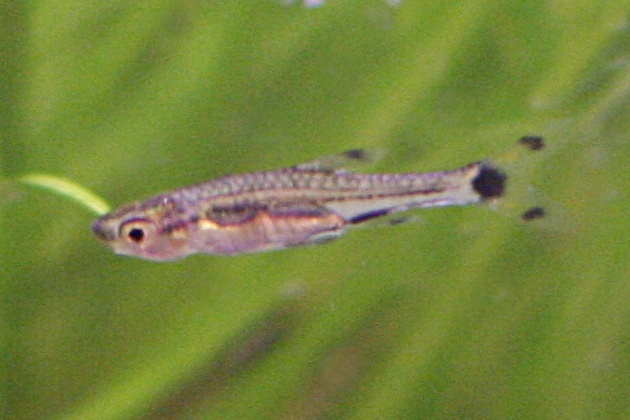
The peaceful and shy Scissortail Rasbora is another schooling fish that often does well with fancy goldfish. These long, thin silverfish sport black markings on their tails and bodies and can reach 6-inches in length. They prefer open areas for swimming and schooling, but often hang out near plants and decorations when they feel unsafe.
If you opt for Scissortails, be sure to get a group of at least 6, and 10 is even better! I recommend allowing 15 to 20 gallons free capacity for a group of 10, and more is usually better. They prefer their temperatures in the 72 to 77°F range and will eat commercial flake foods and fresh, frozen, or dried tubifex and bloodworms.
Bottom Dwelling Tank Mates For Fancy Goldfish
Bottom dwellers like catfish and loaches are often added to community aquariums to scavenge for leftover food scraps and rotting vegetation. Most of these fish are very peaceful, but some species can be territorial and sensitive to having their space invaded. A few options that often do well with fancy goldfish include:
Corydoras Catfish
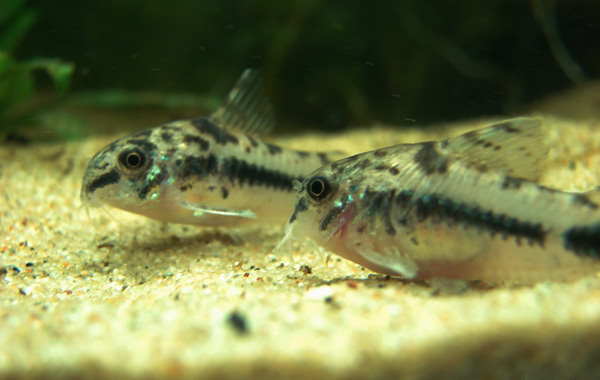
Corydoras Catfish, or Cory Cats as they are commonly called, are a group of over 100 species of small scavenging bottom dwellers commonly found in planted aquarium communities. These peaceful fish come in a variety of sizes, and depending on the species range from 1 to 3 inches in length.
Cory cats are not usually recommended for goldfish tanks because single-tails often grow large enough to eat them, especially the dwarf Corys. But you could likely keep a small school of 6 in a 30-gallon fancy goldfish set-up. If you offer them plenty of hiding places your fancies will probably learn to ignore them. Their ideal temperatures will vary depending on the species you choose.
Hillstream Loach
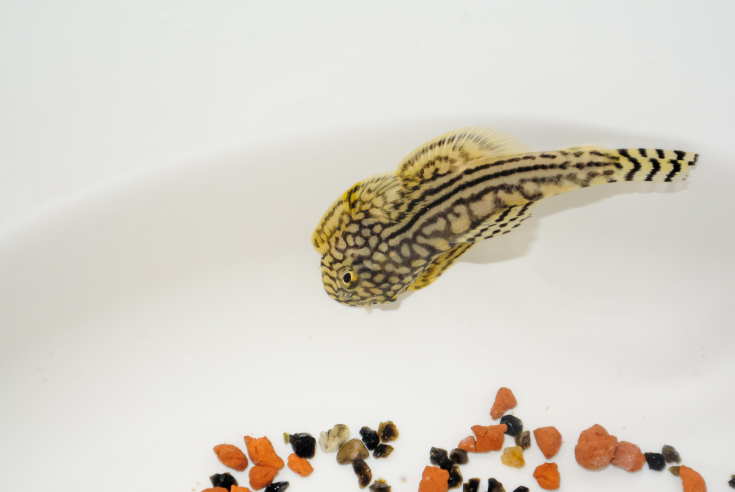
The Hillstream Loach is a shy scavenger that is suitable for ponds as well as aquariums and could work out with either single-tail or fancy goldfish. While they only reach about 3-inches at adulthood, they prefer to hide under rocks, logs, and plants as they search for food. They enjoy cooler 68 to 75°F temperatures, too.
Your goldfish won’t see them very often and they will swim away if the goldfish get nippy. They prefer to live in large aquariums so they can set-up territories, so I would not try to keep these guys in a tank under 55-gallons. If you provide plenty of places to hide and offer them sinking food, they’ll probably do well with your goldfish!
Weather Loach aka Dojo Loach
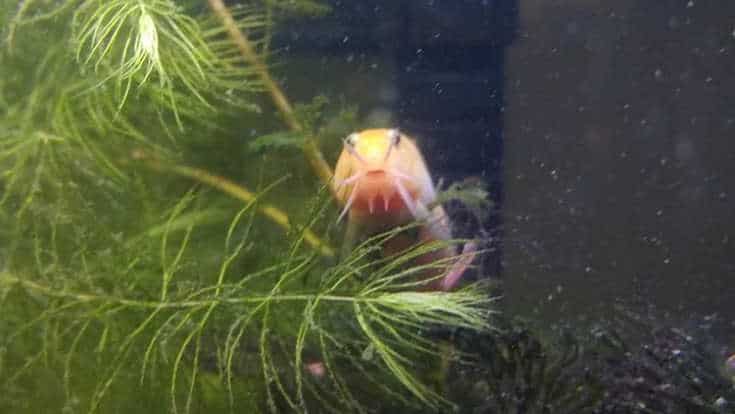
The Weather or Dojo loach is another interesting bottom feeder to consider for your large goldfish tank. These fish are sensitive to changes in barometric pressure and get agitated when a storm is brewing! You’ll need at least 55-gallons to keep a group of 3 and they‘ll often be found in a pile observing the other fish.
One thing that makes these fish especially challenging is their ability to climb. Your tank will need to have a secure lid with vented coverings over every opening, or they may pull a disappearing act on you. I once found my Weather loach hiding in my filtration system after he climbed up the intake and squeezed through a gap!
Goldfish Tank Mates For Advanced Fish Keepers
I can’t honestly recommend the following animals as ideal or even good options for housing with goldfish, but I’ve seen situations where these matches have worked. If your tank is large enough and you have the experience to handle the high-level care some require, these could make for some exotic and unique goldfish companions!
Bamboo Shrimp
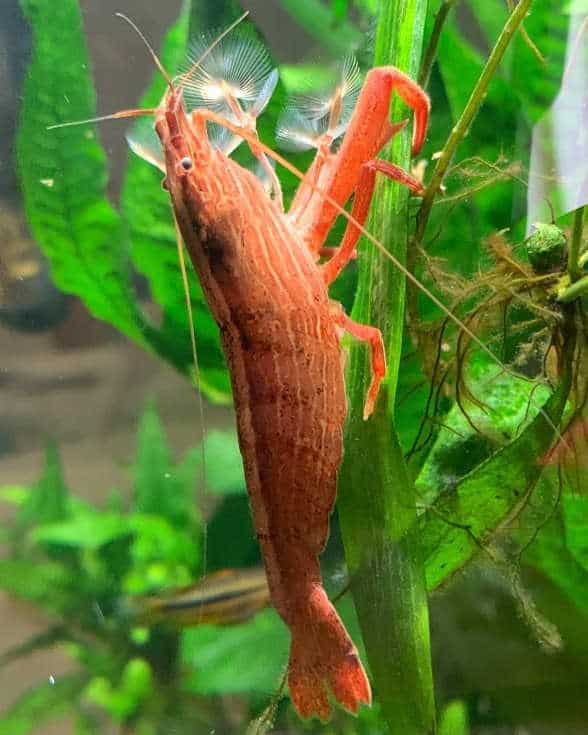
If you are up for a real challenge and have a tank at least 75 to 100 gallons, then you might try keeping an exotic and delicate Bamboo Shrimp with your fancy goldfish. These filter feeders hang out on the decorations in the center of your tank and wave their broad fan-shaped antenna around to capture microscopic particles of food!
It’s hard to prevent bamboo shrimp from starving in a typical aquarium, so you should only try to maintain a single one per tank. You’ll probably have to supplement their diet with powdered spirulina. These are rare and expensive shrimp, and I’d probably only risk them in a tank with very delicate and immobile goldfish like Celestial or Bubble Eyes over the faster Fantails and Orandas.
Ghost Shrimp
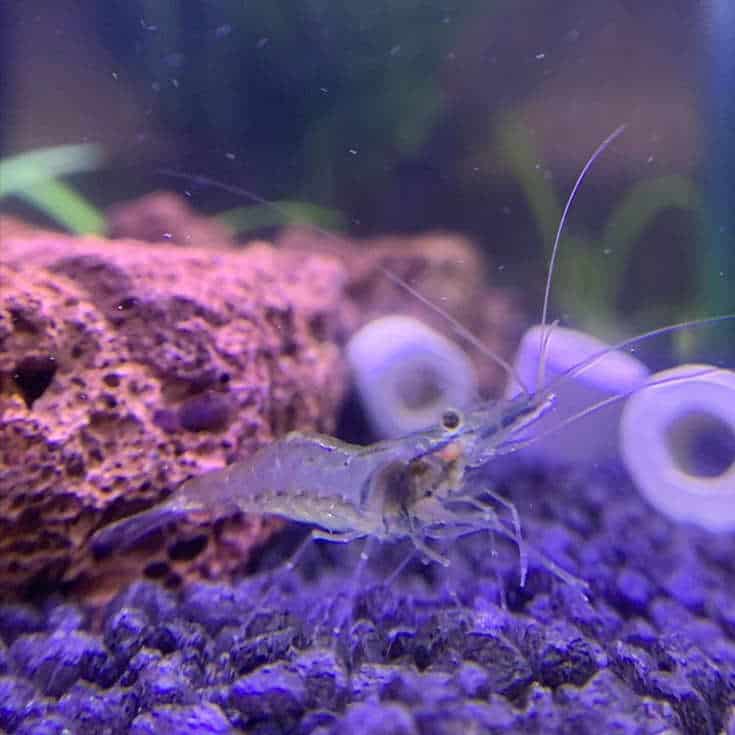
Ghost or Glass Shrimp are a common and popular option for planted community tanks and are useful algae-eating scavengers who spend most of their time sifting through your sandy substrate looking for food. The trick to keeping a group in a goldfish tank is to give them lots of hiding places.
Your goldfish will still probably end up eating at least some of your shrimp since Ghosts rarely grow larger than 1.5-inches in length. But with a plentiful supply of plastic plants, rocks, logs and decorations to hide among, chances are that a few of your shrimp will survive, and they are a lot of fun to observe!
Cherry Shrimp
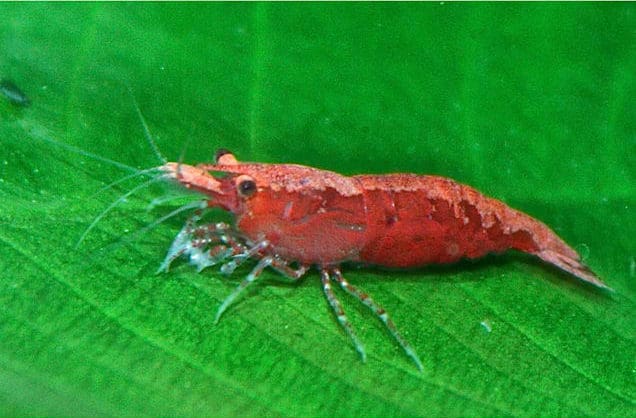
Another possibility is the bright red scavenging Cherry Shrimp! These active invertebrates are the most popular freshwater shrimp in the aquarium trade and can be found inexpensively in many stores and online. They can reach 1.5-inches in length and nearly any aquarium has room for a group.
As with the Ghost Shrimp, the trick to keeping them safe from your goldfish is to provide plenty of hiding places on the bottom of your tank. They also prefer sandy substrates and a lot of plastic plants of varying heights. Since these shrimp are not rare or especially pricy, if things don’t work out you haven’t lost a large investment.
Axolotls
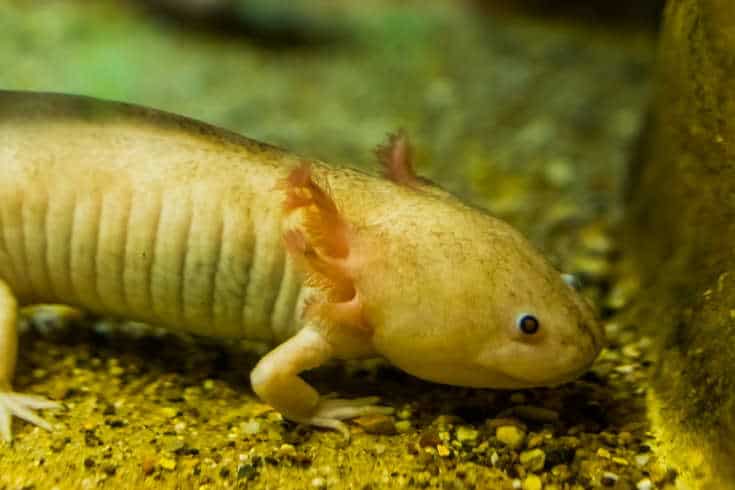
If you really want to try something on the edge, you could keep an aquatic salamander like the Axolotl with your fancy goldfish. It’s not ideal for either species in the long term, but several experienced professionals have pulled it off and it certainly makes for an interesting tank!
Axolotls prefer their water from 70 to 74°F and need a soft, sandy substrate and places to hide during the day. They are nocturnal, and adults can reach up to 12-inches in length, so an Axolotl may hunt your goldfish at night when they are sleeping. If you’re going to try this experiment, I’d use a large 50+ gallon tank for a single salamander and group of fancies, and have another tank standing by just-in-case.
African Dwarf Frogs
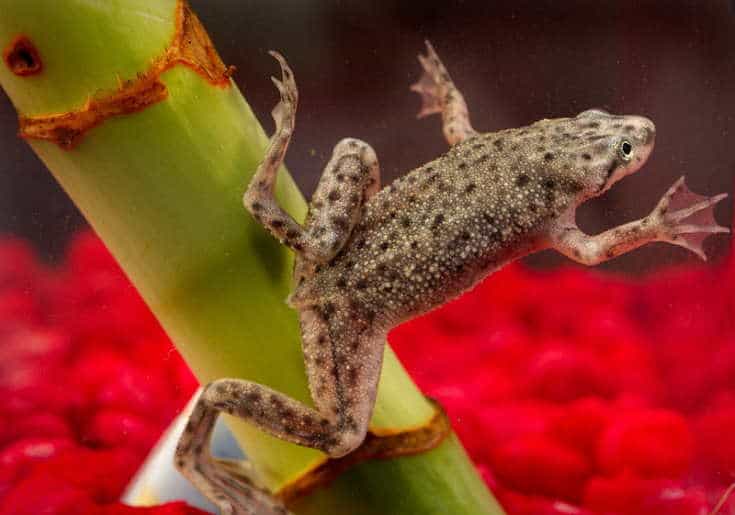
No one told me that it was a bad idea to keep African Dwarf Frogs and feeder goldfish together, and by the time I heard the news my 20-gallon community set-up had been running problem-free for 5 years! I can’t promise it will work in every tank, but they don’t seem any more challenging than keeping shrimp with goldfish!
Dwarf frogs are entirely aquatic and spend most of the day hiding under your decorations and plants. They can reach up to 3-inches in length but many are smaller; it just depends on the specific species you have.
They will often float on the surface of your water breathing air, and if you drop some tubifex worms in the tank they’ll emerge to scarf the scraps. They are not an ideal tank mate, and no one would actually recommend them, but why not try keeping some of these with your single-tail or Fancy Goldfish?
Choosing Tank Mates For Goldfish
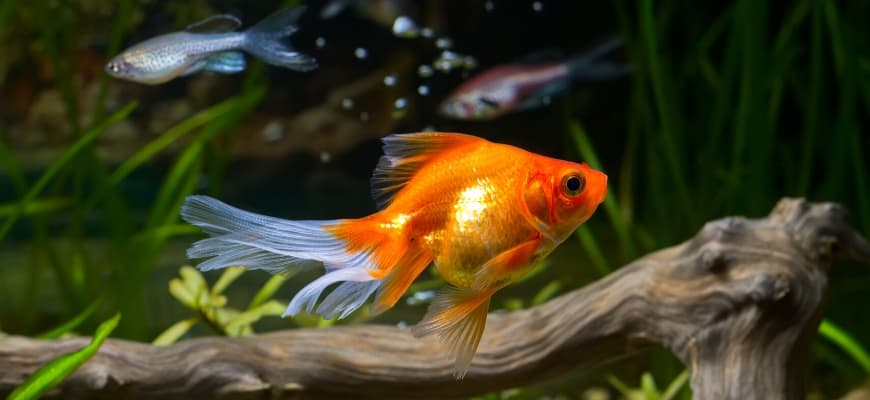
Goldfish (Carassius auratus) have been domesticated for over 2000 years and are probably one of the most diverse aquatic animals in the world. There are more than 200 distinct types of goldfish and they can have dramatically different appearances and care requirements.
This creates a challenge for goldfish keepers when they decide to add new fish to their communities. A good companion for a Common goldfish may be entirely inappropriate for a Celestial. Before we can discuss the best options for your goldfish tank, we need to take a few factors into consideration.
Does Your Goldfish Need A Tank Mate?
Goldfish are, generally speaking, active and curious fish, but they don’t need to have companions to be happy. Adding tank mates to a goldfish habitat is really more of a personal decision than a necessary one. Your goldfish will be content as long as they have a clean tank to explore, plenty of room to swim, and an abundant source of food.
If you decide you’d like to add some companions, however, you’ll want to take into account the following factors as you explore your options:
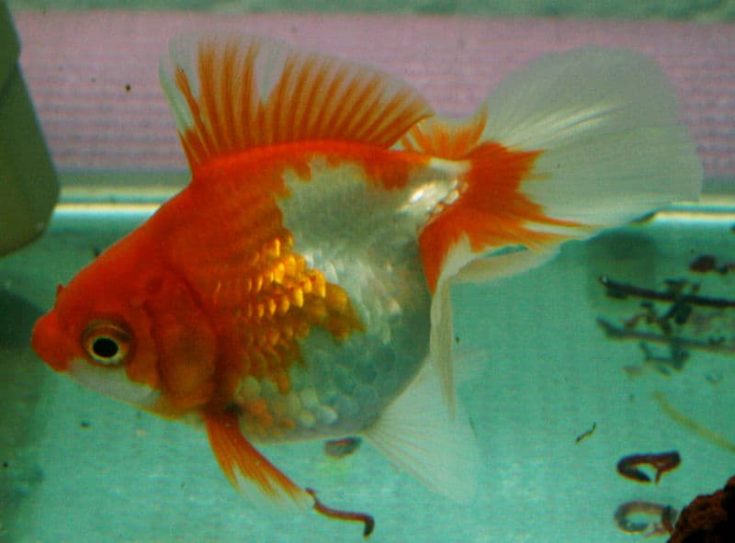
- What kind of goldfish do you have?
- What size is your aquarium and how much room do you have for more fish?
- What’s your set-up like, and does it need any modifications?
Basic Types Of Goldfish
Take a look at your goldfish, and identify the type of fish you have. Do they have a single tail, or a double fantail, or any other special traits? Goldfish can be broken into two primary types based on their body shape and tail design, and this is the most important factor to consider when choosing their tank mates.
Hearty Single Tail Goldfish Compatibility
If you have a hearty-type of goldfish with a slim, streamlined body and a single tail then you don’t have a lot of good choices for companions. These goldfish can get very large and almost always outgrow their tropical tank mates. The best companions for hearty types are other single-tailed goldfish and species suitable for life in a pond.
Fancy Goldfish Compatibility
Fancy goldfish, on the other hand, are smaller at maturity and can’t swim or maneuver in the water as easily as the single-tails. The fancy traits like double-tails, bubble eyes, and their hunched or round bodies slow them down. Oftentimes, you can mix goldfish with tropical fish if you’re careful about your selection.
Aquarium And Filtration Capacity
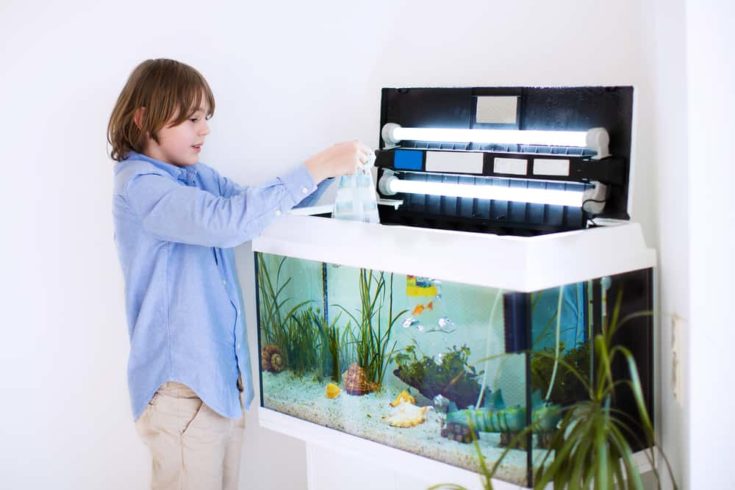
Before you can start looking through my list of tank mates, you’ll need to evaluate your current aquarium to be sure you have room for extra fish and a filtration system that can handle the increased workload. Depending on the number and type of goldfish you have, you might already be near your maximum capacity!
The smallest aquarium recommended for any type of mature goldfish is a 20-gallon tank, and for every additional goldfish, you’ll usually add another 10 to 20 gallons of capacity. Some quick math can reveal how much extra room you have and can help you narrow down the list and number of possible buddies!
Evaluate Your Set-Up And Filtration Systems
Goldfish are eating machines, and spend their time exploring your tank looking for food. They will eat anything they can fit in their mouths. This means they produce a lot of biowastes and need a high-quality multi-stage filtration system to keep their tank clean and neutralize toxins. They don’t like heavy currents and avoid them.
Before you add companion fish to your tank, be sure your filter and set-up can handle the increased load and are suitable for that species and your goldfish. Single tails use the entire tank but like room to swim, and fancies are limited based on their physical traits. You may be able to pick a buddy that prefers an area your goldfish avoids!
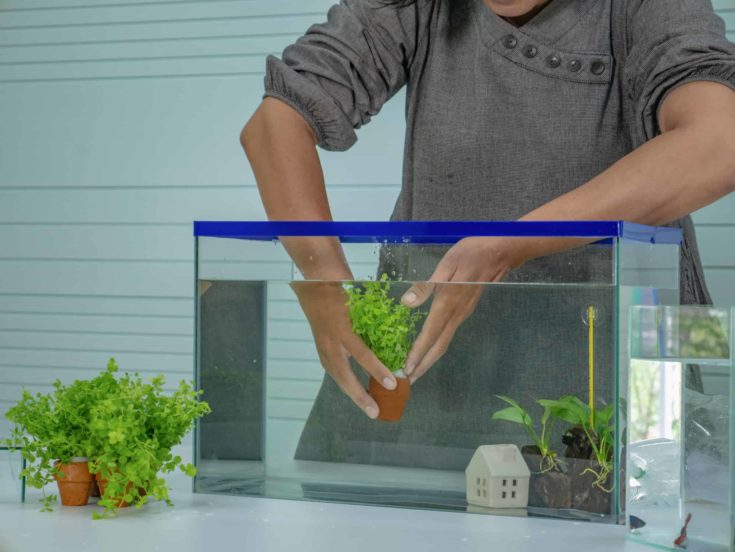
Consider your decor and arrangements as well. While goldfish will eat and uproot live plants, using plastic plants to create hiding spots for other fish, shrimp and snails are one way to increase the chances that a particular mix will work out in your tank. Rocks, logs, and other decors can also give critters a place to hide from your goldfish!
Features Of Ideal Goldfish Companions
Now that you know how your type of goldfish and aquarium set-up factors into the tank mate decision, let’s talk about what makes a particular fish or invertebrate suitable for a goldfish tank.
Temperature Preference
The best companions are those whose ideal temperature range overlaps with your goldfish aquarium.
- Many tropical fish require warm temperatures that are too hot for goldfish to live in comfortably, and this can lead to stress and illness.
- At the same time, keeping tropical fish in cooler water than ideal can be fatal to them.
Size And Fin Length
I’ve already mentioned that goldfish are voracious eaters and will consume anything they can swallow. As omnivores, goldfish are as happy to eat invertebrates and smaller fish as they are their commercial diet!
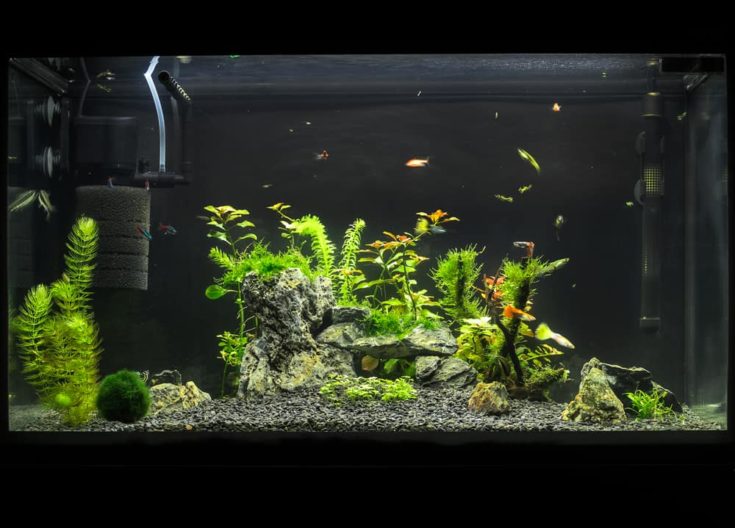
- Shrimp with goldfish is usually a bad idea unless the shrimp are very large or have a lot of places to hide in the tank that the goldfish can’t access.
- Goldfish often eat snails, so avoid Nerite snails and other types with pointed cone-shaped shells that could hurt or kill your goldfish if swallowed.
- Small fish like minnows and goldfish can work out until the goldfish get big enough to eat them. I generally don’t recommend keeping minnows in your goldfish tank, but with the slower fancy types, it sometimes works.
At the same time, larger fish can also cause problems in a goldfish tank. I wouldn’t keep angelfish with goldfish, because your goldfish are likely to chase and harass them.
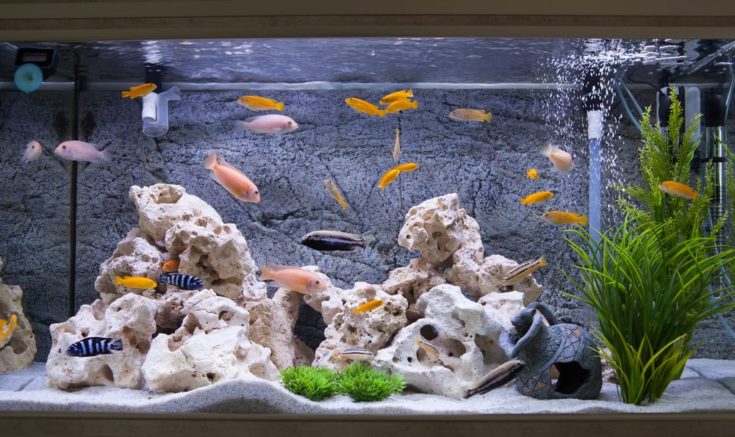
- Goldfish, especially single-tails, can’t resist the temptation to nibble at those long fins.
- It’s best to choose tank mates that are the same size and have short fins.
Swimming Speed And Agility
The best tank mates for your goldfish community are those with similar speed and agility in the water. Slim-bodied single tail goldfish are fast swimmers and will definitely gang up on any fish that are slower than they are. They may also out-compete them for food!
Fancy goldfish may have the opposite problem if they are kept with fast-swimming companions. These goldfish often need special floating diets to accommodate their ponderous swim style, and faster fish might eat all their food. This is why only a few types of tetras and goldfish work out together in the same tank.
Aggression And Territoriality
Goldfish are peaceful and non-aggressive fish and they don’t establish territories or defend an area from other fish. You’ll want to avoid choosing tank mates that are aggressive or semi-aggressive, like African cichlids or Tiger Barbs and stick with friendly species instead.
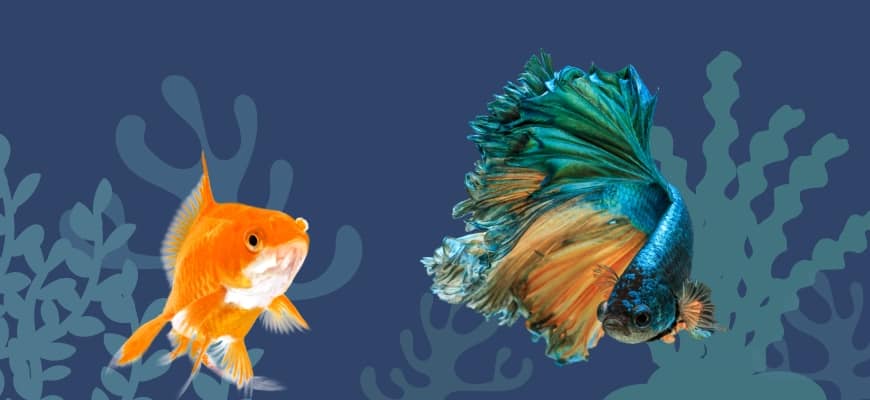
You’ll also want to avoid putting territorial fish in a tank with goldfish, even bottom-dwelling fish that usually avoid the open areas goldfish prefer. Just having your goldfish constantly swimming through their space could cause stress for these companions even if they don’t actively fight to defend the area.
Conclusion
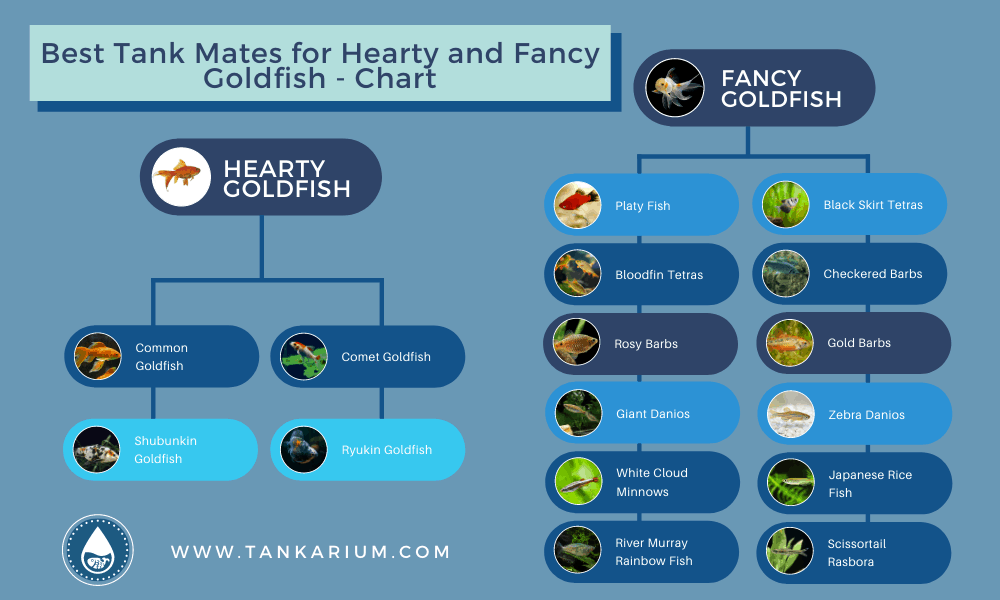
It’s hard to create simple goldfish charts with compatible fish because there is such a wide range of possibilities. The best tank mates will depend on your goldfish’s breed and your aquarium size and set-up. While the ideal tank mate for most goldfish are other similar goldfish, you have many other options if you’re willing to take the risk.
The way to maximize your chance of success is to pay close attention to the capacity of your tank and to rearrange the decor and plants to give each species their ideal and preferred environment. I’d love to hear about your goldfish tank mates, so share some pictures in the comments or join us on social media!
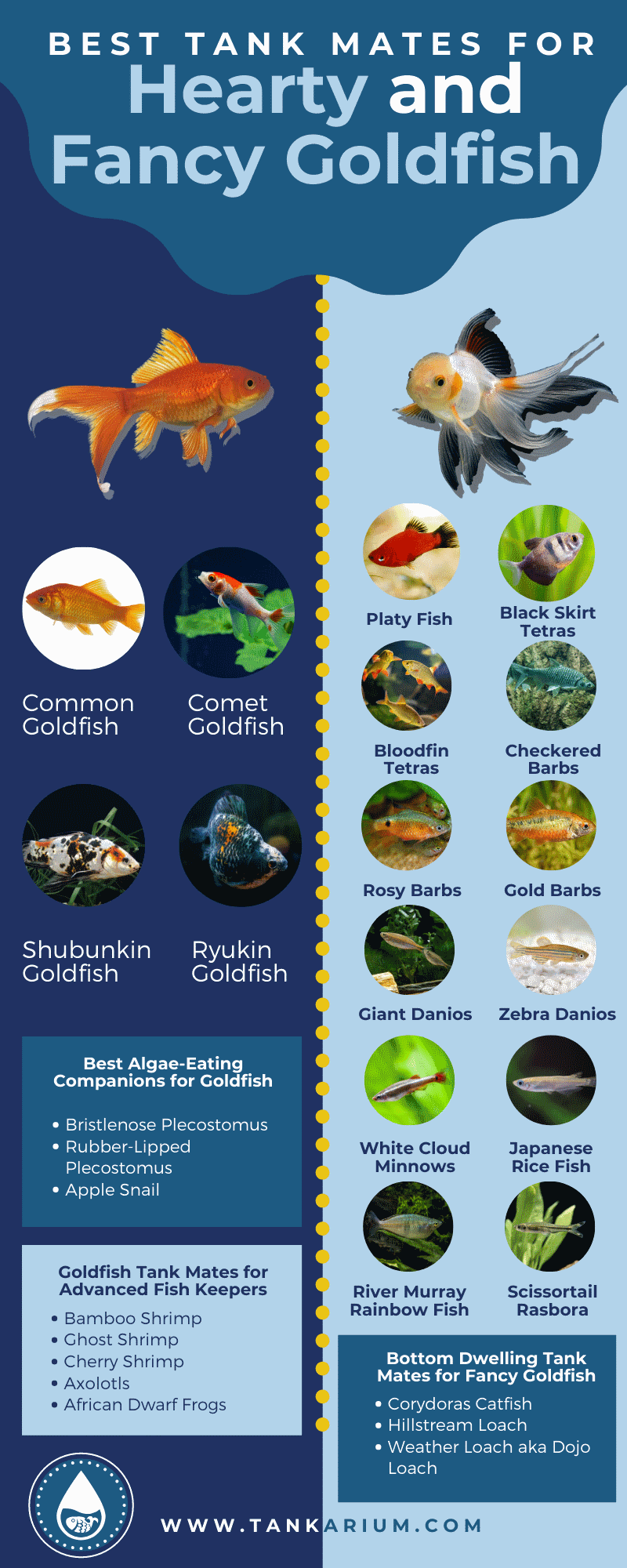
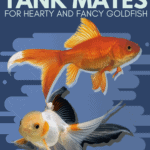
Great advice, you know your subject. I have had a gold fish live quite happily with Orandas, Fantails, Shubunkins, Black moor. I would guess its to do with the size. Admittedly my Plec did not last long. Also interesting to know about minows, platy, danio and barbs that can live quite happily with the fancies. I have never had schooling fish, but think would be a nice addition, guess just need to set a temperature they all like.
Thankyou.
My new, little shubunkin is nipping my quite large fantail. Will they be ok together?
Thank you for your article Jen. I had three 8-in comet goldfish and during the last tank cleaning sadly two of them passed away. The one that is left is very withdrawn and doesn’t eat. Her fins are all laid flat and she just sits at the bottom. She perks up and swims around when I come around but she still doesn’t eat. I was hoping another tank mate would perk her up.
Hi Rhonda! I’m so sorry to hear about the loss of your two comet goldfish! Do you have any idea what may have caused their deaths? Did they pass during the water change, or shortly thereafter? Was there any sign of injury, illness or stress before they passed away. Did they both pass at the same time or one after the other?
I agree that your remaining goldfish may very well be depressed after losing their friends, but I also worry that they may be suffering from the same thing that caused the loss of your other comets. I would hesitate to add any new fish to the tank until you’ve figured out why you lost two during the tank cleaning. If you have a water quality problem or some kind of disease or parasite outbreak that’s hurting your fish, you’d be better off fixing that before you add new goldfish to your community.
Since your comet is seemingly depressed and lonely, though, I agree that they may perk up and recover better if they have some company. If you think there may be a problem with your goldfish tank (rather than the loss being attributed to something that went wrong during the water change but is no longer an issue), you could place a hospital tank right next to your goldfish aquarium and quarantine a couple of new comets in there. That way, your current comet can see them but there’s no chance of passing any illness or parasites between the tanks. If your fish perks up and goes back to their old self, once you’ve finished a week or two of quarantine you can add their new buddies to the tank. Good luck, and let us know how things go!
Thank You fantastic info on Goldfish.